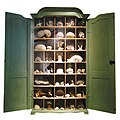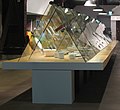Portal:Museums
The Museums Portal
A museum (/mjuːˈziːəm/ mew-ZEE-əm) is an institution dedicated to displaying and/or preserving culturally significant objects. Many museums have exhibitions of these objects on public display, and some have private collections that are used by researchers and specialists. Compared to a library, a museum hosts a much wider range of objects and usually focus around a specific theme such as the arts, science, natural history, local history, and other topics. Public museums that host exhibitions and interactive demonstrations are often considered to be tourist attractions, and many museums attract large numbers of visitors from outside their host country, with the most visited museums in the world regularly attracting millions of visitors annually.
Since the establishment of the earliest known museum in ancient times, museums have been associated with academia and the preservation of rare items. Museums originated as private collections of interesting items, and not until much later did the emphasis on educating the public take root. (Full article...)
Selected museum
The Ford Piquette Avenue Plant is a former factory located within the Milwaukee Junction area of Detroit, Michigan, in the United States. Built in 1904, it was the second center of automobile production for the Ford Motor Company, after the Ford Mack Avenue Plant. At the Piquette Avenue Plant, the company created and first produced the Ford Model T, the car credited with initiating the mass use of automobiles in the United States. Prior to the Model T, several other car models were assembled at the factory. Early experiments using a moving assembly line to make cars were also conducted there. It was also the first factory where more than 100 cars were assembled in one day. While it was headquartered at the Piquette Avenue Plant, Ford Motor Company became the biggest U.S.-based automaker, and it would remain so until the mid-1920s. The factory was used by the company until 1910, when its car production activity was relocated to the new, bigger Highland Park Ford Plant.
Studebaker bought the factory in 1911, using it to assemble cars until 1933. The building was sold in 1936, going through a series of owners for the rest of the 20th century before becoming a museum in 2001. The Piquette Avenue Plant is the oldest purpose-built automotive factory building open to the public. The museum, which was visited by over 31,000 people in 2018, has exhibits that primarily focus on the beginning of the United States automotive industry. The building was added to the National Register of Historic Places in 2002, became a Michigan State Historic Site in 2003, and was designated a National Historic Landmark in 2006. (Full article...)
Selected interior image
Selected general article
Museum architecture has been of increasing importance over the centuries, especially more recently.
A challenge for museum architecture is the differing purposes of the building. The museum collection must be preserved, but it also needs to be made accessible to the public. Climate control may be very important for the objects in the collection. (Full article...)
Did you know...
- ... that a major Asian collection was donated to the National Museum of Ireland – Decorative Arts and History by Jewish benefactor Albert Bender while the museum was headed by Adolf Mahr, head of the Dublin Nazi chapter?
- ... that when the Ivankiv Historical and Local History Museum was burned during the recent Battle of Ivankiv, artworks by Hanna Veres and Maria Prymachenko were destroyed?
- ... that the Springfield Science Museum is home to the oldest operating projection planetarium in the United States?
- ... that King Mohammed VI of Morocco donated part of his royal collection to the new National Jewellery Museum?
- ... that museum director Alena Aladava rebuilt the Belarusian national art collection in the aftermath of the Second World War?
- ... that the Jersey Maritime Museum displays a 7.5-million-stitch tapestry depicting life under Nazi occupation that was worked on by thousands of islanders?
Get involved
For editor resources and to collaborate with other editors on improving Wikipedia's Museums-related articles, see WikiProject Museums.
Selected exterior image
Selected type of museum

A ceramics museum is a museum wholly or largely devoted to ceramics, usually ceramic art. Its collections may also include glass and enamel, but typically concentrate on pottery, including porcelain. Most national collections are in a more general museum covering all of the arts, or just the decorative arts. However, there are a number of specialized ceramics museums, with some focusing on the ceramics of just one country, region or manufacturer. Others have international collections, which may be centered on ceramics from Europe or East Asia or have a more global emphasis.
Outstanding major ceramics collections in general museums include The Palace Museum, Beijing, with 340,000 pieces, and the National Palace Museum in Taipei city, Taiwan (25,000 pieces); both are mostly derived from the Chinese Imperial collection, and are almost entirely of pieces from China. In London, the Victoria and Albert Museum (over 75,000 pieces, mostly after 1400 CE) and British Museum (mostly before 1400 CE) have very strong international collections. The Metropolitan Museum of Art in New York and Freer Gallery of Art in Washington DC (12,000, all East Asian) have perhaps the best of the many fine collections in the large city museums of the United States. The Corning Museum of Glass, in Corning, New York, has more than 45,000 glass objects. (Full article...)
In the news
- 12 May 2024 –
- Forty-nine Vatican Museums employees start an unprecedented labor dispute over unfair and poor working conditions against the Vatican's Pontifical Commission. (Reuters)
- 6 May 2024 –
- The 2024 Met Gala takes place at the Metropolitan Museum of Art in New York City with the theme "The Garden of Time", celebrating the Met's exhibit Sleeping Beauties: Reawakening Fashion. (Vanity Fair)
Subcategories
Subtopics
Lists
- Museums
- Most visited museums (by region)
- Art museums: most visited, largest
Types
- Art museum
- Agricultural museum
- Archaeology museum
- Architecture museum
- Artillery museum
- Aviation museum
- Biographical museum
- Cabinet of curiosities
- Ceramics museum
- Children's museum
- Community museum
- Computer museum
- Design museum
- Dime museum
- Ecomuseum
- Economuseum
- Ethnographic village
- Farm museum
- Fashion museum
- Folk museum
- Food museum
- Green museum
- Hair museum
- Hall of Memory
- Heritage centre
- Historic house museum
- Human rights museum
- Imaginarium
- Interpretation centre
- Jewish museum
- Lapidarium
- Lighthouse museum
- Living museum
- Local museum
- Maritime museum
- Migration museum
- Mobile museum
- Museum ship
- National history museum
- Natural history museum
- Open-air museum
- Palace museum
- Postal museum
- Prefectural museum
- Print room
- Private museum
- Regimental museum
- Schatzkammer
- Science fiction libraries and museums
- Science museum
- Sex museum
- Sculpture garden
- Technology museum
- Textile museum
- Torture museum
- Toy museum
- Transport museum (list)
- University museum
- Virtual museum
- Wax museum
- Writer's home
Related
Associated Wikimedia
The following Wikimedia Foundation sister projects provide more on this subject:
-
Commons
Free media repository -
Wikibooks
Free textbooks and manuals -
Wikidata
Free knowledge base -
Wikinews
Free-content news -
Wikiquote
Collection of quotations -
Wikisource
Free-content library -
Wikiversity
Free learning tools -
Wiktionary
Dictionary and thesaurus







































































